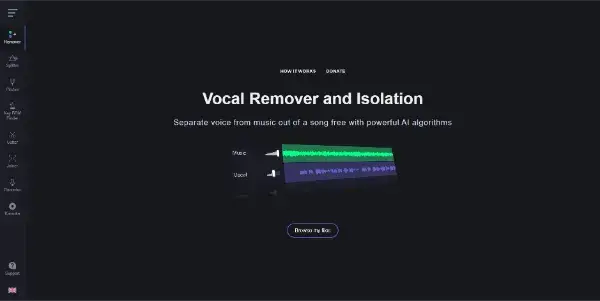Vocal Remover

An AI assistant that can quickly separate voice and music on any kind of song
Vocal Remover AI: A Deep Dive into Free AI-Powered Audio Separation
What is Vocal Remover AI?
Vocal Remover AI is a groundbreaking free tool utilizing artificial intelligence to effortlessly separate vocal tracks from instrumental music in any song. This sophisticated AI assistant analyzes audio files, identifying and isolating the vocal components with impressive accuracy, leaving behind a clean instrumental track or conversely, a pristine isolated vocal track. This capability opens up a wide range of creative possibilities for musicians, producers, and content creators alike.
Main Features and Benefits
- Accurate Separation: The core strength of Vocal Remover AI lies in its ability to accurately distinguish between vocals and instrumentation, even in complex mixes with layered sounds. The algorithm effectively handles various musical genres and recording qualities.
- Speed and Efficiency: Unlike traditional methods of vocal removal that require manual editing and potentially specialized software, Vocal Remover AI provides instant results, significantly reducing processing time.
- Ease of Use: The tool is designed for simplicity, requiring minimal technical expertise. The user-friendly interface allows for quick uploads and seamless processing.
- Free Access: The availability of this powerful tool at no cost makes it accessible to a wider audience, democratizing advanced audio editing capabilities.
- Versatile Output: The separated vocal and instrumental tracks are available for download in high-quality audio formats, suitable for further editing or direct use.
Use Cases and Applications
Vocal Remover AI has a wide range of practical applications across various fields:
- Karaoke Creation: Easily create karaoke tracks by removing vocals from existing songs.
- Remixing and Mashups: Isolate vocals and instrumentals to create unique remixes and mashups, combining elements from different songs.
- Music Production: Clean instrumental tracks are valuable for creating backing tracks, practicing musical instruments, or learning songs. Isolated vocals are useful for vocal processing, layering, and harmony creation.
- Content Creation: YouTubers, podcasters, and other content creators can use the tool to create royalty-free backing tracks for their videos or podcasts, avoiding copyright issues.
- Educational Purposes: Vocal Remover AI can be a valuable tool for music education, allowing students to analyze musical arrangements and practice individual instruments without the distraction of vocals.
- Accessibility: For individuals with hearing impairments, isolating instrumental tracks can improve listening accessibility by reducing vocal distractions.
Comparison to Similar Tools
While several other vocal removal tools exist, many are either subscription-based, limited in functionality, or offer lower quality results. Vocal Remover AI differentiates itself through its combination of:
- Free Access: Many competitors charge a significant fee for access to their services.
- Accuracy: The AI algorithm consistently delivers superior separation accuracy compared to some less sophisticated alternatives.
- Ease of Use: The intuitive interface and straightforward workflow make Vocal Remover AI more accessible to a broader user base than some more complex, professional-grade software.
Pricing Information
Vocal Remover AI is currently completely free to use. There are no subscription fees, hidden costs, or limitations based on usage. This makes it an exceptionally accessible and valuable tool for anyone working with audio.
Disclaimer: While Vocal Remover AI strives for high accuracy, the quality of separation may vary depending on the audio source's complexity and recording quality. In cases with highly complex mixes or poor audio quality, the results may require additional manual editing.